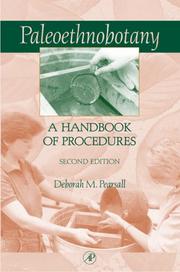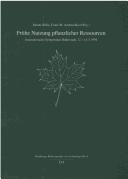| Listing 1 - 10 of 251 | << page >> |
Sort by
|
Book
ISBN: 9780952782704 Year: 2010 Publisher: [place of publication not identified] SAIS
Abstract | Keywords | Export | Availability | Bookmark
 Loading...
Loading...Choose an application
- Reference Manager
- EndNote
- RefWorks (Direct export to RefWorks)
Book
ISBN: 3258028559 Year: 1979 Publisher: Bern : Haupt,
Abstract | Keywords | Export | Availability | Bookmark
 Loading...
Loading...Choose an application
- Reference Manager
- EndNote
- RefWorks (Direct export to RefWorks)
Book
Year: 1991 Publisher: Nitra Archaeological Institute of the Slovak Academy of Sciences
Abstract | Keywords | Export | Availability | Bookmark
 Loading...
Loading...Choose an application
- Reference Manager
- EndNote
- RefWorks (Direct export to RefWorks)

ISBN: 0125480423 Year: 2000 Publisher: San Diego Academic press
Abstract | Keywords | Export | Availability | Bookmark
 Loading...
Loading...Choose an application
- Reference Manager
- EndNote
- RefWorks (Direct export to RefWorks)
Book
Year: 1991 Publisher: Poznań Państwowe Wydawn. Nauk.
Abstract | Keywords | Export | Availability | Bookmark
 Loading...
Loading...Choose an application
- Reference Manager
- EndNote
- RefWorks (Direct export to RefWorks)
Book
ISBN: 9493194434 9789493194434 Year: 2021 Publisher: Groningen : Barkhuis Publishing,
Abstract | Keywords | Export | Availability | Bookmark
 Loading...
Loading...Choose an application
- Reference Manager
- EndNote
- RefWorks (Direct export to RefWorks)
Woodlands are a key source of raw materials for many purposes since early Prehistory. Wood, bark, resin, leaves, fibres, fungi, moss, or tubers have been gathered to fulfill almost every human need. That led societies to develop specific technologies to acquire, manage, transform, elaborate, use, and consume these resources. The materials provided by woodlands covered a wide range of necessities such as food, shelter, clothing, or tool production, but they also provided resources employed for waterproofing, dying, medicine, and adhesives, among many others. All these technological processes and uses are commonly difficult to identify through the archaeological record. Some materials are exclusively preserved by charring or in anaerobic conditions at very exceptional sites or leave only a very slight trace behind them (e.g., containers). Consequently, they have received far less attention in archaeobotanical studies compared to other kind of plant materials consumed as food or firewood.00This book provides an overview of technological uses of plants from the Palaeolithic to the Post-Medieval period. This collection of papers presents different archaeobotanical and archaeological studies dealing with the use of a wide range of woodland resources, most of them among the less visible for archaeology, such as bast, fibres and fungi. These papers present different approaches for their study combining archaeology, archaeobotany and ethnoarchaeology.
Book
ISBN: 1841030023 9781841030029 Year: 2000 Publisher: Otley Westbury and Royal Botanic Gardens, Kew
Abstract | Keywords | Export | Availability | Bookmark
 Loading...
Loading...Choose an application
- Reference Manager
- EndNote
- RefWorks (Direct export to RefWorks)
Plants --- Plants --- Plant remains (Archaeology) --- Plant remains (Archaeology)

ISBN: 3825838943 Year: 1999 Publisher: Hamburg : Lit,
Abstract | Keywords | Export | Availability | Bookmark
 Loading...
Loading...Choose an application
- Reference Manager
- EndNote
- RefWorks (Direct export to RefWorks)
Plant remains (Archaeology) --- Plant remains (Archaeology) --- Europe --- Antiquities
Book
Year: 1971 Publisher: Berlin : Akademie-Verlag,
Abstract | Keywords | Export | Availability | Bookmark
 Loading...
Loading...Choose an application
- Reference Manager
- EndNote
- RefWorks (Direct export to RefWorks)
Book
ISBN: 9789492444912 9492444917 Year: 2019 Publisher: Groningen Barkhuis Publishing
Abstract | Keywords | Export | Availability | Bookmark
 Loading...
Loading...Choose an application
- Reference Manager
- EndNote
- RefWorks (Direct export to RefWorks)
The materiality of plant remains from 36 Neolithic sites of the Linearbandkeramik, Funnel Beaker and Single Grave Culture, and the Dagger groups as uncovered by archaeological excavations in northern central Europe is presented in this atlas to facilitate archaeobotanical investigations by offering photographic references to fossilized charred plant remains and, in some cases, subfossil waterlogged plant remains. The respective archaeological sites are briefly introduced, the plant assemblages shortly evaluated, supported by informations on plant use. Plant lists and new radiocarbon data supplement the volume. The atlas compiles examples of ancient plant remains that were investigated from 2009 to 2019 in three collaborative research programs at Kiel University, SPP1400 "Early Monumentality and Social Differentiation," SFB1266 "Scales of Transformation: Human-Environmental Interaction in Prehistoric and Archaic Societies," and the Botanical Platform of the Graduate School "Human Development in Landscapes" (GSHDL).
| Listing 1 - 10 of 251 | << page >> |
Sort by
|

 Search
Search Feedback
Feedback About
About Help
Help News
News